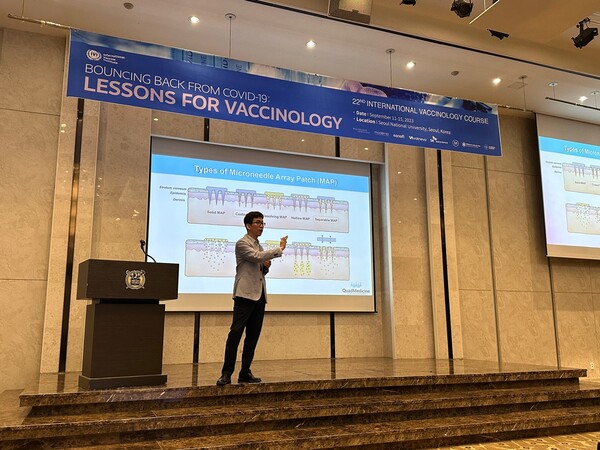Microneedle patch technology is being hailed as the solution to conquer the current limitations of vaccines by offering less invasiveness, painlessness, easier administration, and the potential to address cold chain issues.
However, it still faces limitations hindering its widespread commercialization.

On the sidelines of the International Vaccine Institute's (IVI) International Vaccinology Course, QuadMedicine’s Research Scientist Kim Chi-yong spoke to Korea Biomedical Review about his company's plans to overcome these challenges using advanced microneedle array patches (MAP), in collaboration with other industry partners.
However, QuadMedicine is not only developing the patch for vaccines but diagnostics and treatments as well. For example, the patch can also be applied to glucose monitoring and osteoporosis or obesity treatment. Some of the MAP vaccine applications include hepatitis B, pentavalent (diptera, tetanus, pertussis, hepatitis b and haemophilus influenza type b (HIB)) vaccines, influenza, and measles-rubella (MR) vaccines.
“Although none are yet commercialized, we are taking steps toward commercialization, and expect to soon apply for an investigational new drug (IND) license for a phase 1 trial in Korea and also hope to take some of the other drugs and vaccine candidates out of the preclinical phase soon,” said Kim.
‘Loading the drug onto the needles to achieve maximum efficacy’
Elaborating on the company’s technology, he mentioned that they have developed a few different MAPs but specifically highlighted the coated and separable MAP.
The coated MAP is a combination medical product platform composed of solid microneedles and active pharmaceutical ingredients (APIs). APIs are loaded on the surface of microneedle tips via liquid API or freeze-dried API. Meanwhile, the separable MAP is QuadMedicine’s unique patented technology, which enables immediate delivery of API-containing microneedle tips into the skin upon MAP application. Consequently, it eliminates skin adhesion time, dramatically improves drug delivery, and also alleviates the need for shaving the skin.
“The coated MAP is particularly suitable for global vaccination compared to other types of MAP because it can be produced at an affordable price,” Kim pointed out. “Separable MAP is an attractive option for APIs requiring frequent self-administration as it significantly enhances usability and patient compliance."
Additionally, he added that the coated MAP allows the application of lyophilized vaccines so that separate manufacturing processes to ensure vaccine stability is removed thus increasing the manufacturing speed.
However, he noted that there is no problem regarding MAP compatibility as drugs can be loaded onto the needles in various ways as aforementioned. However, as mRNA was one of the fast-responding platforms, they are now especially conducting research to load the mRNA vaccines and treatments onto the microneedles for maximum efficiency, which he noted as a key area of research interest among global pharmaceutical companies.
“Even if drugs were previously approved, we still have to run separate clinical trials because the route of administration has been changed,” explained Kim. “We have to prove that the patch is delivering the correct doses of the drug through the microneedles.”

Manufacturing challenges a working progress
Due to the small size of the needles, Kim acknowledged there is a limit to the amount of drugs that can be loaded onto the needles which can affect the strength of the doses delivered internally.
However, he mentioned one way to resolve this problem was by incorporating a greater number of needles onto the microneedle array patch (MAP).
“It is also possible to use excipients to tweak the concentration ratio of vaccines and synthetic drugs to enable more direct reaction and ensure the desired drug dosage is delivered to the intended site,” said Kim.
Still, Kim reassured that the company only uses FDA-approved excipients, eliminating concerns about adverse reactions to additives.
He also emphasized the importance of scaling production up and down, a primary concern for production teams, and noted that the Ministry of Food and Drug Safety (MFDS) also deems this crucial during clinical trials.
“Although we started as a research institute, we want to commercialize our technologies and have already established GMP facilities for pre-clinical and phase 1 clinical trials but are currently expanding the automated equipment to be able to accommodate phase 2 and 3 studies for influenza vaccines and osteoporosis treatments.”
Raising another issue, Kim said that his company is also considering price competitiveness for supplying to low- and middle-income countries (LMICs) and trying to find the right partner.
“It requires a lot of consultation with related organizations and we are already engaging in discussions with major institutions related to LMIC vaccine supply such as BMGF, UNICEF, and GAVI,” Kim said. “However, as MAP technologies can drastically reduce the costs related to storage and transport as well as the requirement to dispatch professional medical staff, we believe we have a convincing case.”
What lies ahead for the microneedle industry in Korea
Based on the growing interest in the microneedle industry, the Korean Society of Convergent Research on Microneedle Systems was launched in Korea last month for which QuadMedicine is now a member. Microneedle technology is a convergence medical product that has the characteristics of both medicines and medical devices and it must be able to deliver the correct drug dosage when used as medicines. However, he said it was challenging for one company to develop the medical convergence platform independently and overcome all the regulatory hurdles alone.
Regarding this, he explained that the society was established to facilitate effective communication with the government regarding regulations related to microneedle medicine research, development, and commercialization, as well as to establish a cooperative R&D system involving industry, academia, research, and government.
QuadMedicine is conducting joint contract development organizations (CDO)-level research with three global pharmaceutical companies but could not disclose the specifics of the collaboration due to confidentiality clauses in signed NDA agreements. Domestically, they confirmed that they are actively working together with Hanlim Pharm and Kwang Dong Pharmaceutical on projects to commercialize the microneedle platform.
Related articles
- Juvic makes 'egg microneedle' for patch-type diabetes treatment
- Daewon Pharm applies for trial of patch-type obesity treatment
- [Vaccine Innovation] Microneedle vaccine patches to the rescue
- Abion, Raphas prove strong antibody production with low-voltage microneedle patch for DNA Covid-19 vaccine
- Climate change complicating dengue disease surveillance and vaccine development
- JW Pharmaceutical, Theraject Asia to advance microneedle hair loss treatment

